| Cone peppers | |
|---|---|
 | |
| Species | Capsicum annuum |
| Cultivar group | Conoides group |
Cone peppers, also known as biberi peppers, conic peppers, or conical peppers, are a group of chili peppers within the species Capsicum annuum . [1] [2]
| Cone peppers | |
|---|---|
 | |
| Species | Capsicum annuum |
| Cultivar group | Conoides group |
Cone peppers, also known as biberi peppers, conic peppers, or conical peppers, are a group of chili peppers within the species Capsicum annuum . [1] [2]
Cone peppers are sometimes considered a specific botanical variety, Capsicum annuum var. conoides. This variety is not an accepted name in the Global Biodiversity Information Facility, the Germplasm Resources Information Network, or Kew's Plants of the World Online and is considered a synonym of Capsicum annuum var. annuum. [3] [4] [5]
This group is sometimes called the Capsicum annuum "conoides group" [4] (or conioides group [sic] [1] ).
Cultivars include:

Capsaicin (8-methyl-N-vanillyl-6-nonenamide) is an active component of chili peppers, which are plants belonging to the genus Capsicum. It is a chemical irritant for mammals, including humans, and produces a sensation of burning in any tissue with which it comes into contact. Capsaicin and several related alkaloids are called capsaicinoids and are produced as secondary metabolites by chili peppers, probably as deterrents against certain mammals and fungi. Pure capsaicin is a hydrophobic, colorless, highly pungent, crystalline to waxy solid compound.

The bell pepper is the fruit of plants in the Grossum cultivar group of the species Capsicum annuum. Cultivars of the plant produce fruits in different colors, including red, yellow, orange, green, white, and purple. Bell peppers are sometimes grouped with less pungent chili varieties as "sweet peppers". While they are fruits—botanically classified as berries—they are commonly used as a vegetable ingredient or side dish. The fruits of the Capsicum genus are categorized as chili peppers.

Chili peppers, from Nahuatl chīlli, are varieties of the berry-fruit of plants from the genus Capsicum, which are members of the nightshade family Solanaceae, cultivated for their pungency. Chili peppers are widely used in many cuisines as a spice to add "heat" to dishes. Capsaicin and related compounds known as capsaicinoids are the substances giving chili peppers their intensity when ingested or applied topically. Other varieties of capsicum include bell peppers, but while chili peppers are pungent, bell peppers are not.

Capsicum pubescens is a plant of the genus Capsicum (pepper). The species name, pubescens, refers to the hairy leaves of this pepper. The hairiness of the leaves, along with the black seeds, make Capsicum pubescens distinguishable from other Capsicum species. Capsicum pubescens has pungent yellow, orange, red, green or brown fruits.
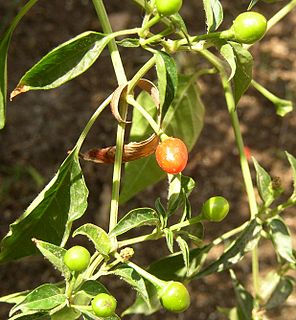
Capsicum annuum var. glabriusculum is a variety of Capsicum annuum that is native to southern North America and northern South America. Common names include chiltepín, Indian pepper, chiltepe, and chile tepín, as well as turkey, bird’s eye, or simply bird peppers, due to their consumption and spread by wild birds, "unlike humans birds are impervious to the heat of peppers". Tepín is derived from a Nahuatl word meaning "flea". This variety is the most likely progenitor of the domesticated C. annuum var. annuum. Another similar-sized pepper, 'Pequin' is often confused with tepin, although the tepin fruit is round to oval where as the pequin's fruit is oval with a point, and the leaves, stems and plant structures are very different on each plant.

Capsicum annuum is a species of the plant genus Capsicum native to southern North America, the Caribbean, and northern South America. This species is the most common and extensively cultivated of the five domesticated capsicums. The species encompasses a wide variety of shapes and sizes of peppers, both mild and hot, such as bell peppers, jalapeños, New Mexico chile, and cayenne peppers. Cultivars descended from the wild American bird pepper are still found in warmer regions of the Americas. In the past, some woody forms of this species have been called C. frutescens, but the features that were used to distinguish those forms appear in many populations of C. annuum and are not consistently recognizable features in C. frutescens species.

Capsicum chinense, commonly known as a "habanero-type pepper", is a species of chili pepper native to the Americas. C. chinense varieties are well known for their unique flavors and many have exceptional heat. The hottest peppers in the world are members of this species, with Scoville Heat Unit scores of over 2 million. Some taxonomists consider them to be part of the species C. annuum, and they are a member of the C. annuum complex; however, C. chinense and C. annuum pepper plants can sometimes be distinguished by the number of flowers or fruit per node – two to five for C. chinense and one for C. annuum – though this method is not always correct. The two species can also hybridize and generate inter-specific hybrids. It is believed that C. frutescens is the ancestor to the C. chinense species.
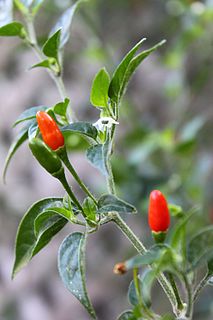
Pequinpepper is a hot chili pepper cultivar commonly used as a spice. Pequin peppers are very hot, often 5–8 times hotter than jalapeños on the Scoville scale. Flavor is described as citrusy, smoky, and nutty.
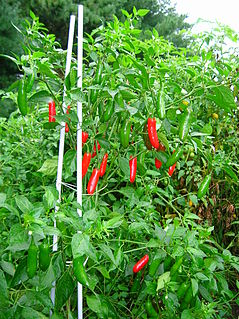
The serrano pepper is a type of chili pepper that originated in the mountainous regions of the Mexican states of Puebla and Hidalgo. The name of the pepper is a reference to the mountains (sierras) of these regions. The pepper is commonly used to make giardiniera.

Capsicum baccatum is a member of the genus Capsicum, and is one of the five domesticated chili pepper species. The fruit tends to be very pungent, and registers 30,000 to 50,000 on the Scoville Heat Unit scale.
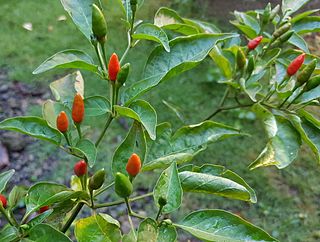
Siling labuyo is a small chili pepper cultivar that developed in the Philippines after the Columbian Exchange. It belongs to the species Capsicum frutescens and is characterized by triangular fruits which grow pointing upwards. The fruits and leaves are used in traditional Philippine cuisine. The fruit is pungent, ranking at 80,000 to 100,000 heat units in the Scoville Scale.
Colletotrichum capsici is a species of fungus and plant pathogen which causes leaf blight on Chlorophytum borivilianum, basil, chickpea and pepper as well as dieback in pigeonpea and anthracnose in poinsettia.

The facing heaven pepper, is a type of cone pepper, a group of cone-shaped, medium-hot chili peppers within the species Capsicum annuum. The species is native to Central America.

The peter pepper, Capsicum annuum var. annuum, is an heirloom chili pepper that is best known for its unusual shape. It is a type of Capsicum annuum, though it is not officially recognized as a cultivar of the species. It occurs in red and yellow varieties. The pepper is considered very rare and its origin is unknown.

Siling haba, espada, siling mahaba, siling pangsigang, siling Tagalog, and sometimes called green chili, finger chili or long pepper, is one of two kinds of chili common to the Philippines and Filipino cuisine, the other being siling labuyo. Unlike siling labuyo, it belongs to the species Capsicum annuum.

Padrón peppers, also called Herbón peppers, are a variety of peppers from the municipality of Padrón in northwestern Spain.

Capsicum is a genus of flowering plants in the nightshade family Solanaceae, native to the Americas, cultivated worldwide for their chili pepper or bell pepper fruit.

The cayenne pepper is a type of Capsicum annuum. It is usually a moderately hot chili pepper used to flavor dishes. Cayenne peppers are a group of tapering, 10 to 25 cm long, generally skinny, mostly red-colored peppers, often with a curved tip and somewhat rippled skin, which hang from the bush as opposed to growing upright. Most varieties are generally rated at 30,000 to 50,000 Scoville units.
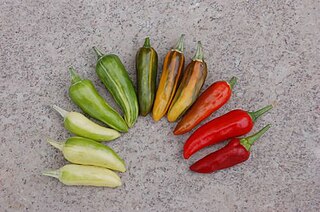
The fish pepper is a small Chili pepper cultivar of the species Capsicum annuum. It is a historical variety from African-American communities in the Chesapeake. The plant has variegated foliage and the peppers ripen from white with green streaks to a dark red color. Its pungency can range, with scoville heat units from 5,000 to 30,000.